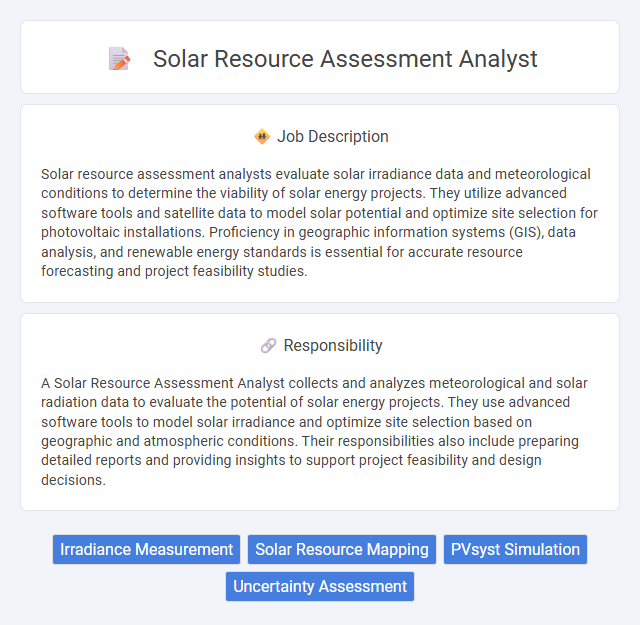
Solar resource assessment analysts evaluate solar irradiance data and meteorological conditions to determine the viability of solar energy projects. They utilize advanced software tools and satellite data to model solar potential and optimize site selection for photovoltaic installations. Proficiency in geographic information systems (GIS), data analysis, and renewable energy standards is essential for accurate resource forecasting and project feasibility studies.
Individuals with strong analytical skills and a passion for renewable energy are likely well-suited for a Solar Resource Assessment Analyst role. Those comfortable working with geospatial data, meteorological information, and advanced software tools may find this job aligns with their abilities and interests. People who prefer structured problem-solving and have attention to detail might have a higher probability of thriving in this position.
Qualification
A Solar Resource Assessment Analyst requires expertise in remotely sensed data, GIS software such as ArcGIS or QGIS, and proficiency in modeling solar irradiance using tools like PVsyst or SAM. Strong analytical skills in meteorological data interpretation and experience with satellite-based solar data sources, including NASA and SolarGIS, are essential. A background in environmental science, renewable energy engineering, or related fields, combined with knowledge of photovoltaic system performance, ensures accurate solar potential evaluations.
Responsibility
A Solar Resource Assessment Analyst collects and analyzes meteorological and solar radiation data to evaluate the potential of solar energy projects. They use advanced software tools to model solar irradiance and optimize site selection based on geographic and atmospheric conditions. Their responsibilities also include preparing detailed reports and providing insights to support project feasibility and design decisions.
Benefit
Solar resource assessment analysts likely enhance project efficiency by accurately measuring and interpreting solar data, which may boost energy production forecasts. Their expertise probably reduces financial risk by providing reliable resource estimations, appealing to investors and stakeholders. This role might also contribute to sustainable energy adoption by optimizing solar power system designs and locations.
Challenge
Solar resource assessment analyst roles likely involve complex data interpretation challenges due to variable weather patterns and geographic differences. The probability of encountering incomplete or inconsistent data sets may complicate accurate solar irradiance modeling. Managing these uncertainties often requires advanced analytical skills and the ability to integrate multiple data sources effectively.
Career Advancement
A Solar Resource Assessment Analyst specializes in evaluating solar energy potential using meteorological data and geospatial analysis, essential for optimizing solar project designs and ensuring energy yield accuracy. Mastery of tools like PVsyst, GIS software, and proficiency in climate modeling significantly enhances career prospects, enabling progression to senior technical roles or project management in renewable energy firms. Continuous skill development in advanced data analytics and renewable energy policy further accelerates advancement into strategic positions within solar energy consulting or development companies.
Key Terms
Irradiance Measurement
Solar resource assessment analysts specialize in irradiance measurement to accurately evaluate solar energy potential at specific locations. They utilize advanced instruments like pyranometers and reference cells to collect high-resolution solar radiation data, ensuring precise modeling of photovoltaic system performance. Expertise in analyzing temporal and spatial variability of irradiance supports optimized solar project design and reliable energy yield predictions.
Solar Resource Mapping
Solar resource assessment analysts specialize in evaluating solar energy potential through advanced solar resource mapping techniques. They utilize satellite data, meteorological information, and geographic information systems (GIS) to create detailed solar irradiance maps that optimize site selection for photovoltaic installations. Accurate solar resource mapping enhances energy yield predictions, project feasibility, and overall solar power system performance.
PVsyst Simulation
Solar resource assessment analysts specializing in PVsyst simulation evaluate site-specific solar energy potential using advanced modeling software to optimize photovoltaic (PV) system design and performance. They analyze solar irradiance data, weather patterns, and shading effects to generate precise energy yield predictions and support feasibility studies. Expertise in PVsyst allows for detailed simulations of system losses, enabling accurate forecasting and enhanced project development for solar power installations.
Uncertainty Assessment
A Solar Resource Assessment Analyst specializing in Uncertainty Assessment evaluates the reliability and variability of solar data to improve energy yield predictions for photovoltaic projects. They apply statistical models and satellite data analysis to quantify factors such as irradiance fluctuations, atmospheric conditions, and sensor errors that impact resource estimation accuracy. This uncertainty quantification supports risk mitigation strategies and financial feasibility analyses crucial for solar energy project development.
 kuljobs.com
kuljobs.com